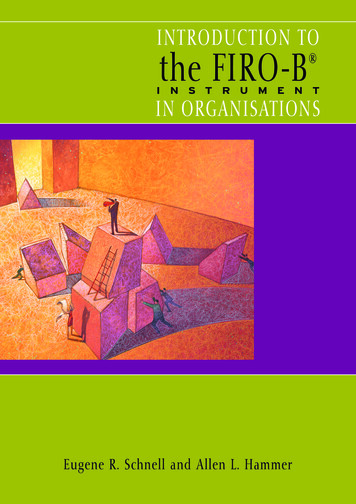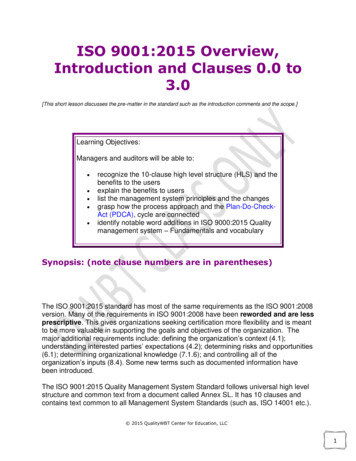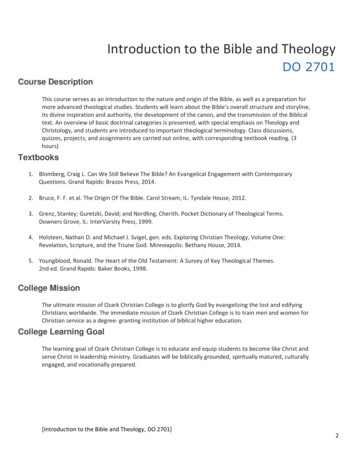
Transcription
INTRODUCTION TOthe FIRO-BINS TR UMEN TIN ORGANISATIONSEugene R. Schnell and Allen L. Hammer
THE FIRO‑B MODELThe letters in the acronym FIRO‑B stand forFundamental Interpersonal Relations Orienta tionTM‑ Behaviour. Originally developed to pre dict howmilitary personnel would work together in groups,this short instrument was created by William Schutzand was first fully described in his book FIRO : AThree‑Dimensional Theory of Interpersonal Behavior (1958).The theory underlying the FIRO‑B instrumentincorporates ideas from the work of the eminentpsychologists T.W. Adorno, Erich Fromm and WilfredBion.The FIRO‑B instrument has become a widelyused assessment that helps those who take it tounderstand interpersonal behaviour. Many peoplefind the FIRO‑B instrument useful in career, familyand relationship counselling, management andleadership development, and teambuilding. TheFIRO‑B instrument also has been used in mpatibility, inter personal dynamics in groups,and criminal jus tice administration. The reliabilityand validity of the instrument has been clearlydemonstrated (see GA Gluck in the References listedon page 25).You will be better able to use your FIRO‑B resultsif you understand the model on which it is based.2Before we begin, however, a caveat is in order. Allinstruments have limitations. The FIRO‑B instrumentis not: A comprehensive personality test A judgment about “bad” or “good” behaviours or“bad” or “good” people A measure of abilities, career interests orachievement.Remember, no one should make a serious lifedecision based on the results of a single psychologicalinstrument.As you think about the meaning of your scores,keep in mind that a number of extraneous fac torsmay have affected how you responded to the FIRO-Bitems. Try to determine if any of these may haveinfluenced your responses: Life events that lead to intense self‑reflection orwithdrawal from others Cultural differences affecting the expression ofneeds Misunderstanding the terms Consciously trying to avoid extreme responses Pressure from the environment to express certainbehaviours.
Table 1: The Six‑Cell ModelINCLUSION (I)CONTROL (C)AFFECTION (A)ExpressedBehaviourExpressed Inclusion (el)Expressed Control (eC)Expressed Affection (eA)WantedBehaviourWanted Inclusion (wI)Wanted Control (wC)Wanted Affection (wA)Adapted from W. Schutz, The FIRO Awareness Scales Manual. Mountain View, CA: CPP, Inc., 1978.The Three Interpersonal NeedsThe FIRO‑B assessment measures interpersonalneeds in these three areas:The FIRO‑B instrument is based on a model thatidentifies three interpersonal needs: Inclusion, Controland Affection. Table 1 shows the terminology used inthe six‑cell model that forms the basis of the FIRO‑Binterpretation. We will define each of these needswith the descriptors in Table 2, and then describehow each can be either Expressed or Wanted. Finally,we will pull it all together in Table 3 and then, inTable 4, provide behavioural examples of each cell ofthe model. The remain ing sections of Part 1 will thenexplain the FIRO‑B scores. In Part 2, we will discussappli cations of your FIRO‑B results. The need for Inclusion relates to forming newrelationships and associating with people, anddetermines the extent of contact and promi nencethat a person seeks. The need for Control relates to decision- making,influence and persuasion between people, anddetermines the extent of power or dominancethat a person seeks. The need for Affection relates to emotional tiesand warm connections between people, anddetermines the extent of closeness that a personseeks.Table 2: Characteristics Associated with the Three Interpersonal ceregulatedwarmth3
Table 3: The FIRO-B ModelExpressed(e)Wanted(w)INCLUSION (I)CONTROL (C)AFFECTION (A)I make an effort to include others in myactivities. I try to belong, to join socialgroups – to be with people as much aspossible.I try to exert control and influence overthings. I enjoy organising things anddirecting others.I make an effort to get close to people.I am comfortable expressing personalfeelings and I try to be supportive ofothers.I want other people to include mein their activities and to invite me tobelong. I enjoy it when others noticeme.I feel most comfortable working inwell-defined situations. I try to get clearexpectations and instructions.I want others to act warmly towardsme. I enjoy it when people sharetheir feelings with me and when theyencourage my efforts.Adapted from W. Schutz, The FIRO Awareness Scales Manual. Mountain View, CA: CPP, Inc., 1978.Expressed and Wanted NeedsFor each of the three interpersonal needs – Inclusion,Control and Affection – the FIRO-B instrument alsoprovides a measure of how much each need isexpressed or wanted by you. According to FIROtheory, the extent to which a person will initiatethe behaviour is called the Expressed dimension ofthe need, and the extent to which a person prefersto be the recipient of those behaviours is calledthe Wanted dimension of the need.For example, if you are very interested in initiatingbehaviours that control or regulate the activities ofothers, you probably have a high need for ExpressedControl. If, on the other hand, you are very interestedin having your work assignments clearly spelled outand structured, then you probably have a high needfor Wanted Control.4Similarly, your level of Expressed Affection willdetermine how much you show support and caringfor others, while your level of Wanted Affection willdetermine how much you accept encouragementand personal interest expressed by others.Expressed and Wanted behaviours operatedynamically between individuals. How individualsrespond to Expressed behaviour from others willdepend on how much they want that type ofbehaviour. In this way, Wanted behaviour representshow much Expressed behaviours from others areaccepted and tolerated.Table 3 displays the complete FIRO-B model,showing how the expressed and wanted dimensionsrelate to the three needs for Inclusion, Control andAffection.Table 4 provides additional behavioural examplesof each of the six possible combinations.
Table 4: Behaviours Associated with the Three NeedsExpressed(e) INCLUSION (I)CONTROL (C)AFFECTION (A)Behaviours indicatingExpressed Inclusion (el)Behaviours indicatingExpressed Control (eC)Behaviours indicatingExpressed Affection (eA)Talking and joking with othersTaking a personal interest in othersInvolving others in projects andmeetingsRecognising the accomplishmentsof othersIncorporating everyone’s ideas andsuggestionsOffering helpful information or“tips” to new colleagues Wanted(w) Frequenting high-traffic areas (eg,the coffee machine)Wearing distinctive clothingDecorating the work space withpersonal mementoesSeeking recognition orresponsibilityGetting involved in high-profileprojects and activitiesGoing along with the majorityopinion Behaviours indicatingWanted Inclusion (wI) Assuming positions of authorityAdvancing an idea within thegroupTaking a competitive stance andmaking winning a priorityManaging the conversationInfluencing others’ opinionsEstablishing structured tasks,procedures, policiesBehaviours indicatingWanted Control (wC) Asking for help on the jobInvolving others in decision-makingRequesting precise instructions andclarificationDeferring to the wishes, needs andrequests of othersAsking for permission andcirculating progress detailsRaising issues for others toconsiderReassuring and supportingcolleagues, both verbally andphysicallyGiving gifts to show appreciationExhibiting concern about thepersonal lives of othersBeing trustworthy and loyalSharing personal opinions orprivate feelings about issuesCoaching and developing othersBehaviours indicatingWanted Affection (WA) Being flexible and accommodatingListening carefully to othersDisplaying an open body postureSharing feelings of anxiety,sadness, lonelinessTrying to please othersGiving others more than they wantor need5
Team RolesPeople play many roles in groups. The roles that youplay depend on your interpersonal needs and theneeds of other team members. Your FIRO‑B resultscan help you understand the roles you prefer whenworking in a team. Table 11 provides examples ofFIRO‑B scores and the roles that team members withthese scores can be predicted to assume.The closer your FIRO‑B score is to the followingexamples, the more likely you are to assume theseroles in group settings. Scores that fall in the mid dle range may indicate that you take on one of thefollowing roles only under certain circum stances.Individuals with low eI, low eC or low eA generallydo not consistently initiate activity within the team.These individuals tend to be more receptive andreactive so their Wanted scores should be used todetermine which roles they are likely to assume ina group.Table 11: Team Roles Suggested by FIRO‑B Results16ScoresRoleDescriptionHigh ExpressedInclusionClarifierPresents issues or solutions for clarification, summarises discussion, introduces new members to theteam, keeps team members up to date, provides group with facts and data.High WantedInclusionTension-ReducerHelps move the team along by joking or clowning at appropriate moments, redirects group at tensemoments, builds on common interests in the group.Low WantedInclusionIndividualistIs not an active team player, sees meetings as unnecessary or distracting, may work on other tasksor hold side conversations during meetings, may not follow through or cooperate with group decision.High ExpressedControlDirectorPushes for action and decision-making, may interrupt others or monopolise the “air-time” in meetings,may be unrealistically optimistic about what can be accomplished.High WantedControlQuestionerSeeks orientation and clarification, is a constructive critic of the team and its members, may usequestions to postpone closure or decisions.Low WantedControlRebelStruggles to establish a position within the group, may criticise others, challenges the status quo,may refuse to comply with group decisions, provides alternative ideas but may have difficulty withfollow-through.High ExpressedAffectionEncouragerBuilds the ego or status of others, is friendly, responsive, warm, diplomatic, may sacrifice the truth tomaintain good relationships.High WantedAffectionListenerMaintains participative attitude and interest non-verbally, is involved in group goals, shows interest byreceptive facial and bodily expressions.Low WantedAffectionCautionerExpresses concern about direction of the group, relays doubts about the success of initiatives planned,shows reluctance to get swept up in group energy, provides careful analysis of potential problems,may play devil’s advocate.
A comprehensive personality test A judgment ab out “bad” or “good” behaviours or “bad” or “good” people A measure of abilities, career interests or achievement. Remember, no one should make a serious life . decision based on the results of a single psychological i










